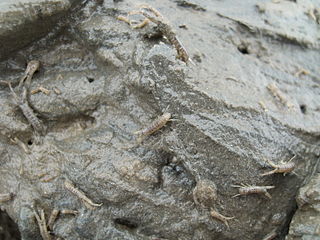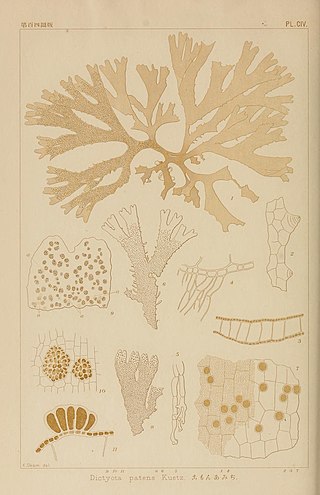
Amphipoda is an order of malacostracan crustaceans with no carapace and generally with laterally compressed bodies. Amphipods range in size from 1 to 340 millimetres and are mostly detritivores or scavengers. There are more than 9,900 amphipod species so far described. They are mostly marine animals, but are found in almost all aquatic environments. Some 1,900 species live in fresh water, and the order also includes the terrestrial sandhoppers such as Talitrus saltator and Arcitalitrus sylvaticus.

Gammaridea is one of the suborders of the order Amphipoda, comprising small, shrimp-like crustaceans. Until recently, in a traditional classification, it encompassed about 7,275 (92%) of the 7,900 species of amphipods described by then, in approximately 1,000 genera, divided among around 125 families. That concept of Gammaridea included almost all freshwater amphipods, while most of the members still were marine.

Corophiidae is a family of amphipods, containing the following genera:
Bateidae is a family of amphipod crustaceans, comprising the single genus Batea, which in turn contains thirteen species:
Ochlesidae is a family of amphipods. They are very small, often less than 1.5 millimetres (0.06 in) long, and are found mainly in tropical and subtropical areas of the Southern Hemisphere. The family Odiidae has sometimes been subsumed into Ochlesidae.
Phliantidae is a family of isopod-like amphipod crustaceans chiefly from the southern hemisphere.

Pardaliscidae is a family of amphipods, whose members typically inhabit the deepest parts of ocean basins. It contains the following genera:

Oedicerotidae is a family of amphipods. It comprises the following genera:

Lysianassidae is a family of marine amphipods, containing the following genera:
Paracalliopiidae is a family of amphipods, containing the following genera:

Gammaridae is a family of amphipods. In North America they are included among the folk taxonomic category of "scuds", and otherwise gammarids is usually used as a common name.

Phronima sedentaria is a species of amphipod crustaceans found in oceans at a depth of up to 1 km (0.6 mi). They are large in size relative to other members of the family Phronimidae. Individuals may be found inside barrel-like homes, created most commonly from the tunics of select species of tunicate, where they rear their young. P. sedentaria is known to employ multiple feeding strategies and other interesting behaviors, including daily vertical migration. The species is also known by the more common names “pram bug” and “barrel shrimp.”

Pontogeneiidae is a family of amphipod crustaceans, containing the following genera:

Atylidae is a family of amphipod crustaceans, containing the following genera:

Alicellidae is a family of amphipod crustaceans, which live as scavengers in the deep sea, often in association with hydrothermal vents. The family includes the following genera:
Martensia martensi is a species of amphipod crustacean, and the only species in the genus Martensia. It occurs in waters around Svalbard at depths of 37–95 metres (121–312 ft).
Sunamphitoe femorata is a species of amphipod crustacean in the family Ampithoidae. It is a herbivore and constructs a tubular nest-like home on a blade of the sporophyte of the giant kelp Macrocystis pyrifera. This home is made by rolling the sides of the blade together and securing them with silk. As the kelp blade grows, the nest is advanced down the blade towards the base, approximately keeping pace with the algal growth.

Haustorius is a genus of amphipods in the family Haustoriidae. There are about six described species in Haustorius.

Ampithoidae is a family of amphipod crustaceans. The family has a worldwide distribution as algal dwellers. They commonly create tube-shaped nests on their host plants or algae which serve as both shelter and food. Young ampithoids develop from eggs to a larval stage within their mother's brood-pouch, formed by the appendages of her abdomen.

Dictyota bartayresiana, commonly known as a forded sea tumbleweed, is a species of brown alga found in the tropical western Indo-Pacific region and the Gulf of Mexico. It contains chemicals that are being researched for possible use as antimicrobials, as larvicides and as cytotoxins.











